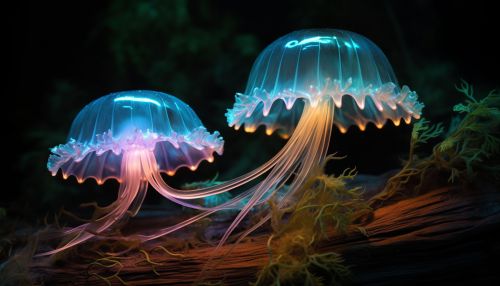Bioluminescence
Introduction
Bioluminescence is a fascinating natural phenomenon characterized by the emission of light by a living organism. This process occurs due to a chemical reaction that takes place within the organism, involving a light-emitting molecule and an enzyme, commonly known as luciferin and luciferase respectively. Bioluminescence is observed in various marine organisms, certain fungi, bacteria, and some insects, such as fireflies. This article delves into the science behind bioluminescence, its occurrence in nature, and its applications in various scientific fields.


Biochemistry of Bioluminescence
The biochemical process of bioluminescence involves the oxidation of luciferin in the presence of the enzyme luciferase. This reaction results in the production of light, along with the formation of an inactive oxyluciferin. The exact chemical reaction varies depending on the species, as different organisms use different types of luciferin and luciferase. The light produced can range from blue to green, yellow, and even red, depending on the species and the environment.
Occurrence in Nature
Bioluminescence is primarily observed in marine organisms, including fish, squid, and jellyfish. It is also seen in some terrestrial organisms like fireflies and certain species of fungi. The phenomenon serves various purposes in different species, such as attracting prey, deterring predators, and communication.
Marine Bioluminescence
Marine bioluminescence is observed in a wide range of organisms, from bacteria to large squids and fish. The most common form of marine bioluminescence is blue light, which travels farthest in water. However, certain deep-sea organisms produce red light, which is invisible to many marine animals, thereby providing a stealthy form of communication.
Terrestrial Bioluminescence
On land, bioluminescence is less common but is observed in organisms like fireflies and glow-worms, which use it for attracting mates. Certain fungi also exhibit bioluminescence, often referred to as foxfire, which is believed to attract insects that aid in spore dispersal.
Applications of Bioluminescence
Bioluminescence has numerous applications in various scientific fields, including medicine, genetics, and environmental science. In medicine, it is used for imaging and detecting certain diseases. In genetics, bioluminescent genes are often used as markers to track the expression of other genes. In environmental science, bioluminescence is used to measure levels of certain pollutants, as the light production in some organisms is affected by these substances.
Conclusion
Bioluminescence is a captivating natural phenomenon that has intrigued scientists for centuries. Its diverse occurrence in nature and its myriad applications in various scientific fields make it a fascinating area of study. As research progresses, it is likely that new aspects of bioluminescence and its potential uses will continue to be discovered.
